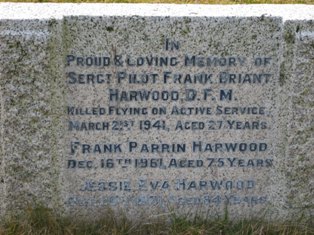|
Sergeant Frank Harwood is listed in the
LONDON GAZETTE
dated 11 February 1941 page 833
Distinguished Flying Medal (DFM)
The DFM was instituted together with the DFC in 1918, and was awarded to NCOs and men for bravery whilst flying on operations against the enemy. All DFMs were named with the recipient's details around the rim of the medal. The World War One medals had the details impressed. The Second World War DFMs had the details engraved.
During World War I, approximately 105 DFMs were awarded, with 2 first award bars. During World War II, approximately 6,000 DFMs were awarded, with 60 first award bars and 2 second award bars.
All the DFM awards are listed in the London Gazette. A few of the First World War entries have a citation. The majority of Second World War DFM awards have citations.
Following the 1993 review this medal has been replaced by the Distinguished Force Cross, which is now available to all ranks.
|
SERGEANT FRANK BRIANT HARWOOD, DFM, 740429, 207 Squadron, Royal Air Force Voluteer Reserve
Born
2nd September 1913, the son of Frank Parrin Harwood and Jessie Eva Harwood. Husband of Betty Harwood. Died on 21st March 1941 aged 27.Remembered with Honour in WEST GRIMSTEAD CHURCHYARD (N.W. corner)

No 207 (Reserve) Squadron
No 207 Squadron is a direct descendant of No 7 Squadron of the Royal Naval Air Service, which was one of the first to operate the Handley Page O/100 heavy bomber during the First World War. On 1 April 1918 , the Squadron was re-numbered as No 207 Squadron Royal Air Force and, shortly after, re-equipped with the Handley Page O/400.After the War, it became part of the Army of Occupation in Germany before returning to the UK and disbanding on 20 January 1920 .
A new No 207 Squadron came into existence on 1 February 1920 , equipped with the DH9A bomber. In 1922, it was one of four squadrons sent to Constantinople to defend the Allied neutral zone. In 1935, equipped with the Fairey Gordon, No 207 Squadron was one of eleven squadrons deployed to the Middle East in response to the Italian invasion of Abyssinia . On its return to the UK in 1936, it became part of the newly-formed Bomber Command, being equipped in turn with the Vickers Wellesley and the Fairey Battle. In September 1939, No 207 Squadron was designated a Group Pool squadron and, in April 1940, was merged with two other squadrons to form No 12 Operational Training Unit.
No 207 Squadron was reformed on 1 November 1940 , becoming the first squadron equipped with the Avro Manchester heavy bomber. However, the Manchester suffered recurrent engine problems and, starting in January 1942, was replaced on No 207 Squadron by the Avro Lancaster. During the Second World War, the Squadron flew 4563 operational sorties on 481 raids, losing 148 Manchesters and Lancasters plus a further 27 aircraft destroyed in crashes; the Squadron suffered 954 fatalities, whilst its personnel were awarded 7 DSOs, 115 DFCs, and 92 DFMs.
Post-war, the Squadron was equipped in turn with the Lincoln, Washington, and Canberra before, in March 1956, being equipped with the Valiant as part of the V-Force, with which it deployed to Luqa as part of the Malta Bomber Wing during the Suez Crisis. Following the Government decision to scrap the Valiant fleet, No 207 Squadron disbanded on 1 May 1965 .
On 3 February 1969 , the Strike Command Communication Squadron at Northolt, equipped with the Basset, Devon and Pembroke, was re-titled No 207 Squadron. The Squadron performed its relatively routine tasks for just over 15 years, before disbanding in June 1984. Another 18 years were to pass before the Squadron re-appeared in July 2002, this time as No 207 (Reserve) Squadron at Linton-on-Ouse
|
|
